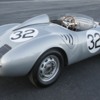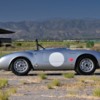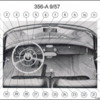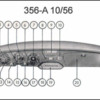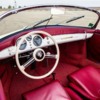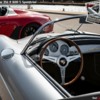Why or what makes one of the replicas, Speedster or Spyder, be labeled or titled as a 1955 or a 1957?
Just wondering...
Replies sorted oldest to newest
The Speedsters are mostly "1957" because of the teardrop tail lights, I believe, and the three big gauge dash. Beehives were a little earlier, and most of those cars got the big tach and speedometer with like one little oil temp gauge in the middle...but there was some overlap, right around 1957, wherein the beehive tail lights and three gauge dash might be found on the same car. Anyway it's arbitrary....they're just kit cars.
The Spyders might be considered "1955" if they have no "gill" inlets in the rear fenders, and "1957" if they do have those louvres, which were distinguishing feature of the later 550A. This is similarly bullshit, as some of the earliest 550s also had cuts in the rear fenders (although slightly different than the later "A" cars had) and the real 1957 550A body was subtilely different in many dimensions from the 1955 Spyder, whereas our fiberglass versions are much more like one another than the originals. So, again, an arbitrary conceit to occupy unsophisticated minds such as our own.
^^^What Ed said^^^ It's all in the details (the bodies themselves are almost exactly the same) and in the end- does it really matter?
@ALB posted:^^^What Ed said^^^ It's all in the details (the bodies themselves are almost exactly the same) and in the end- does it really matter?
It's actually kind of hard to figure out what matters in the end. Do you want a speedster replica:
- to fool the Porsche owners
- as a tribute to an amazing car (who cares what those P-heads think)
- as a status symbol (either a cheap b*stard in a unique, plastic, clown car or a rich b*stard in a $300K antique, precision motorcar)
- to avoid driving something like every other car on the road
- to be able to modify it so it is exactly how you like it (without catching grief for cutting up a real one)
- because it puts a smile on your face
- because it puts a smile on the faces of people you pass
- because you know that there will always be something to fix or change to get it the way you want - you'll never be bored
- fill in the blank _________________________________________________
It doesn't really matter why you've caught the madness, but figuring out why will sometimes make a difference in what you buy and how you fix it up.
@edsnova posted:The Spyders might be considered "1955" if they have no "gill" inlets in the rear fenders, and "1957" if they do have those louvres, which were distinguishing feature of the later 550A. This is similarly bullshit, as some of the earliest 550s also had cuts in the rear fenders (although slightly different than the later "A" cars had) and the real 1957 550A body was subtilely different in many dimensions from the 1955 Spyder, whereas our fiberglass versions are much more like one another than the originals. So, again, an arbitrary conceit to occupy unsophisticated minds such as our own.
The distinguishing feature of a late 55-58 550a is that they have a “birdcage” space frame vs the steel beam ladder frame of the 550.
The real ones also had no hinged clamshell. The rear bodywork came completely off. The rear body work was more slanted (the spare tire was moved up front) the grills were longer/lower and they had the carb/oil tank access grills. 

As such, I would say there is no such thing as a 57 Spyder replica, even though the frames of Greg’s cars differ significantly from the originals and his bodies incorporate the louvered grills in the rear fenders.
Attachments
Most replica owners will sneer at my OCD kicking in over this point, but if you buy a 1390mm speedometer cable and move a few wires around on the cable bundle, you can put the speedometer into the right side and the combo multi gauge on the left side. It just feels better to me on my highly improper outlaw. Just saying.
I put the speedo on the left, I've seen it both places on Spyders, but mostly on the left.
The real reason it's there is to prevent the passenger from seeing how fast you're going!
Actually @dlearl476, the pictures you show are of the coupe and cabriolet dash, which is completely different from the Speedster.
1955 Pre-A first, then 1956 A.
Attachments
I worked up this comparo with a guy who has restored a '55 Speedster and is well versed in the originals (Pre-A through B) and their quirks. It's up under the "Knowledge Section" under the Resource tab. Maybe a non-donating member can see it, too:
https://www.speedsterowners.com/pages/356-a-changes
The only aberation to this list are the few infamous "hybrids" built in mid-to-late 1956 that had the three gauge dash but also had Bee Hive tail lights, as the factory worked off parts in the pipeline. Last I saw early this year, one of those was approaching $700K in valuation showing that it pays to have something rare, even if it doesn't look THAT different.
Replicas are a whole different breed and while I've seen a few that are close to the originals, astute original owners can pick out a replica in about fifteen seconds (without tapping it to see if it is fiberglass).
For you Spyder guys and gals, I believe that Rainer Cooney at the Spyder Factory has a copy of the configuration lists of Spyders consigned to customers, but I don't know how complete those are because of how they were built (in different locations before customer delivery). Bear in mind that only 90 or so were ever built - there are WAY more replicas rolling around out there in the wild. @edsnova is probably the most cognizant of Spyder configurations on here.
One thing Michael is that some of the guys here have owned their replica since early 2000 or before when you could have bought an original for little money but chose a replica for Restomod reasons rather than spend their time restoring a classic they would not want to drive or would drive with little performance, and many idiosyncrasies. Just saying.
Also I had the speedo on the left on my old IM but now on the right and I like it better in that location.
Since I own an IM they name their roadster after the 1959 convertible D model the only year they were made but I am sure the year is flexible.
@Lane Anderson posted:Actually @dlearl476, the pictures you show are of the coupe and cabriolet dash, which is completely different from the Speedster.
1955 Pre-A first, then 1956 A.
I should have kept reading! ![]()
@dlearl476 posted:The distinguishing feature of a late 55-58 550a is that they have a “birdcage” space frame vs the steel beam ladder frame of the 550.
The real ones also had no hinged clamshell. The rear bodywork came completely off. The rear body work was more slanted (the spare tire was moved up front) the grills were longer/lower and they had the carb/oil tank access grills.
As such, I would say there is no such thing as a 57 Spyder replica, even though the frames of Greg’s cars differ significantly from the originals and his bodies incorporate the louvered grills in the rear fenders.
Yep. The nose on the A car was a little longer and lower, and the tail lights were different. And I think those rear grills—set lower and wider apart than on the customer run of 550s—were also hinged?
Then too there was the low-axle transaxle. And five speeds...some of them with a proper shift pattern.
—Almost all of which details were hard to make out from period photos of cars on race tracks.
Hey @DannyP did the 550A stick with 16-inch wheels or did they go to the wider 15s?
The details of these cars were subtilely variable and it's hard now, 65 years later, to pin down the truth. Some guys insist that there were 550 Spyders (not 550As) factory equipped with a 5-speed transmission. I await their evidence.
Even official sources can be mistaken. Just today I read an original 550 owners manual, dated 1954-55, which claims those cars came equipped with a single windshield wiper—a fact not apparent from period photos, existing examples of the car, whether original or meticulously restored. . . or other pages of the same manual, which divulges the existence of no switch to control said wiper.
So it makes sense—from the perspective of being "Period Correct"—for us, PCCA members, to just wing it.
Attachments
I'll look up the 550s tomorrow RE: wheel size and 4-5 speed. The nose was rounder and pointier on a 550a vs. the 550. The oil cooler intake was a duct instead of a grille.
The turn/tail lights appear to be beehives from the Speedster but mounted from behind rather than on the surface.
The standard headrest was hinged at the front edge to allow the LONG carb doors(almost to the center of the car) to open. Yes, the rear grilles were placed lower, wider apart, and hinged.
The 550 had the oval cockpit bulkhead, but the 550a did not.
The frame was a lot of small tubes on the 550a vs the 75mm ladder frame on the 550. The body was made of lighter alloy because of MANY more attachment points. The cars weighed 1100 pounds instead of the 1200-1300 of the 550.
The 30 or so 550a cars did indeed have a low-pivot swingaxle, which was a slight improvement.
I don't think a single one of the 550 or 550a were exactly alike, LOTS of variations.
According to Rainer Cooney, Porsche didn't make the 550 frames - He suspects that they were made by a tubing company to Porsche engineering prints and shipped to whomever was assembling them to the body (again, not Porsche). Many of the tubes are subtly ovaled, not round, too, with the ovals in specific areas to add strength in particular directions. Original 550 frames are wicked stiff, too. I think Rainer explains some of this in the Spyder Factory video.
In my many hours perusing type550.com, it seems like most of the variations are in the factory race cars, almost as if they had subtle differences for every race. Notably the larger “fin” rear fenders of the PanAmerica and Mille Miglia cars. Then, of course, there’s the enclosed cars for endurance races like LevMans.
It seems like the production customer cars were more uniform.
One thing I found interesting is that some of the early cars had pushrod 356 motors in them. According to an article I read somewhere else, the Fuhrman wasn’t deemed reliable enough early on. I believe that one of two later cars were customer orders with the 356 motor as well. I’ve never read about any 5 speed cars, but Type550.com doesn’t cover any “A’s”.
@edsnova posted:Hey @DannyP did the 550A stick with 16-inch wheels or did they go to the wider 15s?
So it makes sense—from the perspective of being "Period Correct"—for us, PCCA members, to just wing it.
Curious myself I found this on the Road Scholars website:
Spyder Wheels
From 1954 to 1956 Porsche’s production aluminum-bodied 550 Spyders were equipped with slotted 16×3.5-inch lightweight wheels. These wheels had a steel center and an aluminum rim. The 1956-1958 550A Spyders were originally fitted with the same wheels and could be fit with a steel/alloy wheel in 15×4, 15×4.5, or 15×5-inch sizes. 15×5.5 size lightweight wheels were available for racing.
Amen to pp2 ![]()
@dlearl476 Dave, the earlier 4-cam engines had roller bearing crankshafts. While they had reduced friction, they were also subject to detonation if the engine were lugged for any reason. Miss a shift and stand on it and lug it for even a few seconds and the power pulses would shatter a bunch of rollers and your bearing(s) were toast. That might be why some cars had pushrod engines.
Later on they went to alloyed Babbitt bearings similar to what we run today, and increased reliability a lot.
The first few cars got regular engines to race with because the 547 engines weren't ready.
Once ready, the 547 engines were very reliable but they did require care. In the early days Porsche reportedly did issue a warning not to over-rev the 4-cam engines (beyond 6200 rpm?) but I think that was under certain conditions.
The 1955 owners' manual (page 18) specified a "sustained" max RPM of 6000 in normal driving and 6500 when racing, with 7500 authorized for "short periods."
@edsnova posted:The first few cars got regular engines to race with because the 547 engines weren't ready.
Once ready, the 547 engines were very reliable but they did require care. In the early days Porsche reportedly did issue a warning not to over-rev the 4-cam engines (beyond 6200 rpm?) but I think that was under certain conditions.
The 1955 owners' manual (page 18) specified a "sustained" max RPM of 6000 in normal driving and 6500 when racing, with 7500 authorized for "short periods."
That right there ^^^ in yellow. Much later on, some of the 4-cams plain old wore out and were replaced by cheap racers(predecessors of PCCA members) with pushrod motors. Remember, these were racecars, meant to be used and discarded after a couple seasons. The fact that any remain at all is amazing.
I suspect my engine is authorized at 7500 rpm for "short periods." Like 3 nanoseconds.
I've been trying to upload a video of a four-cam Pat Downs had on his dyne but I keep getting an error message. @Theron has something changed in our permissions because I could upload videos all the time from my iPhone or my Mac and I never had any issues. Now I can't upload videos anymore.
The only way I could do it was to upload to Youtube and link or embed. I live an Apple-free life though...
Per Type550.com 550-01 and 550-02 both had pushrod engines from the factory. 550-03 got the first 4-cam but when Porsche sold it after racing it in the 1953 Carrera Panamericana both it and 550-04 also were re-fitted with pushrod engines before sale.
It is worth noting that those pushrod engines—the early 1500 "Super" engines—were also fitted with the built-up Hirth roller bearing crankshafts. (Read this link to learn about Porsche/VW's use of wood in these engines!)
I can find scant mention of the roller cranks failing due to low RPM lugging. They certainly never developed the reputation for failure that the MG XPAG cranks of the day endured. I suspect when worn out they were replaced with regular cranks because those were more readily available, cheaper and often offered the opportunity to stroke the engine a little bigger.
Ed, agreed.
@DannyP posted:The only way I could do it was to upload to Youtube and link or embed. I live an Apple-free life though...
One time when I was staring a thread simply to post a video, I selected the Post Content button, then resource, and it let me upload directly from my photo gallery on my phone.
But, AFAIK, the Post Content menu is only available for new threads.
Uploading to YouTube and posting the link is the only reliable way I’ve ever been able to post videos.
@dlearl476 posted:One time when I was staring a thread simply to post a video, I selected the Post Content button, then resource, and it let me upload directly from my photo gallery on my phone.
But, AFAIK, the Post Content menu is only available for new threads.
Uploading to YouTube and posting the link is the only reliable way I’ve ever been able to post videos.
Used to be you could use the "Add Attachments" link and post a video. Now it doesn't seem to ever work for me with videos. Only photos.
@edsnova posted:I can find scant mention of the roller cranks failing due to low RPM lugging. They certainly never developed the reputation for failure that the MG XPAG cranks of the day endured. I suspect when worn out they were replaced with regular cranks because those were more readily available, cheaper and often offered the opportunity to stroke the engine a little bigger.
Even then, roller cranks were (and remain today) a spectacularly expensive and complicated solution in search of a problem.
Of all the things creating friction and heat in an engine, the crankshaft journals (riding as they are on a skin of oil) are pretty inconsequential. Like 99% of what I think of as "perfect engineering", plain journal bearings are are brilliant in their effectiveness and simplicity.
It's not unlike the contact-patch comment from yesterday - things that seem to be so are not necessarily actually so.
Stan, you're probably right, but a roller bearing crank is still a cool thing.
@DannyP posted:Stan, you're probably right, but a roller bearing crank is still a cool thing.
I'm the king of needless complexity, but a roller crank is a bridge too far, even for me.
Back around 1990 I bought a mystery motor from a guy who’s father had built it in the mid 1980’s for a VW bus. I remember pulling a valve cover, the heads had dual springs, looked really clean inside. I think I gave $250 for it. As we were loading it up, the guy mentioned he had some carbs for it sitting in a box. He said I could have the carbs and manifolds for another $100. The carbs were 48 IDA’s. I get the motor home and tear it down and it had a 82mm SPG roller crank in it. The crank had been pinned and welded. I ran it in a drag car at 7500 rpm for several seasons until I lost a flywheel and ovaled out the dowel pins. Crank was super smooth running, but very heavy, as they were a full circle design.
Sometime in the late, late '70's or early 80's my friend Don (proprietor of a VW performance shop, may he RIP and where I learned a lot about all this stuff, after hours drinking far too much beer in the shop instead of going back to school) built a stock cammed 1750 with dual port heads, kadrons and roller crank for his brother's '67 Beetle. Well, that thing went like it had an Engle W110; it was incredible! The reason guys liked them was they made power. The problem was keeping them together- engines only lasted 30,000 miles tops, you couldn't lug them at all and the slightest bit of detonation turned the aluminum rod bearing cages into junk right now!
SPG Roller Crank?
HA! a new rabbit hole for me to dive down!


